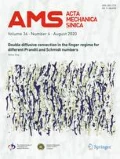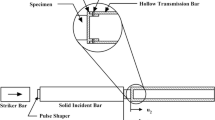Abstract
Experimental and numerical simulations were undertaken to estimate the effects of imperfect conditions on stress waves in split Hopkinson pressure bar (SHPB) experiments. The photonic Doppler velocimetry (PDV) measurement results show that the rise and fall times of an incident wave increases with an increasing inclination angle; also, the fluctuations of the incident wave disappear gradually with the increase of inclination angle. The following characteristics for various defects in the SHPB were obtained by numerical simulation: (1) the influence of a curved bar was negligible; (2) misalignment modestly affects the fluctuation characteristics, and bending waves were generated at this condition; (3) inclination and indentation of the impact end-surface had a great impact on the incident waves, and both of them increase the rise time of the incident wave by increasing the degree of defects. In view of the results, misalignment, inclination, and indentation in SHPB experiments should be minimized.















Similar content being viewed by others
References
Hopkinson, B.: A method of measuring the pressure produced in the detonation of high explosives or by the impact of bullets. Philos. Trans. R. Soc. Lond. A 213, 437–456 (1914)
Kolsky, H.: An investigation of the mechanical properties of materials at very high rates of loading. Proc. R. Soc. Lond. B 62, 676–700 (1949)
Davies, R.: A critical study of the Hopkinson pressure bar. Philos. Trans. R. Soc. London A 240, 375–457 (1948)
Chen, W.N.W., Song, B.: Split Hopkinson (Kolsky) Bar: Design, Testing and Applications. Springer, New York (2011)
Zhu, J., Hu, S., Wang, L.: An analysis of stress uniformity for concrete-like specimens during SHPB tests. Int. J. Impact Eng. 36, 61–72 (2009)
Meng, H., Li, Q.: Correlation between the accuracy of a SHPB test and the stress uniformity based on numerical experiments. Int. J. Impact Eng. 28, 537–555 (2003)
Nemat-Nasser, S.: Introduction to high strain rate testing, ASM Handbook, ASM International, OH, pp. 427–428 (2000)
Nemat-Nasser, S., Isaacs, J.: Direct measurement of isothermal flow stress of metals at elevated temperatures and high strain rates with application to Ta and TaW alloys. Acta Mater. 45, 907–919 (1997)
Zhao, H., Abdennadher, S., Othman, R.: An experimental study of square tube crushing under impact loading using a modified large scale SHPB. Int. J. Impact Eng. 32, 1174–1189 (2006)
Bailly, P., Delvare, F., Vial, J., et al.: Dynamic behavior of an aggregate material at simultaneous high pressure and strain rate: SHPB triaxial tests. Int. J. Impact Eng. 38, 73–84 (2011)
Li, Y., Guo, Y., Hu, H., et al.: A critical assessment of high-temperature dynamic mechanical testing of metals. Int. J. Impact Eng. 36, 177–184 (2009)
Shazly, M., Prakash, V., Lerch, B.A.: High strain-rate behavior of ice under uniaxial compression. Int. J. Solids Struct. 46, 1499–1515 (2009)
Yang, L., Shim, V.: An analysis of stress uniformity in split Hopkinson bar test specimens. Int. J. Impact Eng. 31, 129–150 (2005)
Zhao, H.: Material behaviour characterisation using SHPB techniques, tests and simulations. Comput. Struct. 81, 1301–1310 (2003)
Merle, R., Zhao, H.: On the errors associated with the use of large diameter SHPB, correction for radially non-uniform distribution of stress and particle velocity in SHPB testing. Int. J. Impact Eng. 32, 1964–1980 (2006)
Lifshitz, J., Leber, H.: Data processing in the split Hopkinson pressure bar tests. Int. J. Impact Eng. 15, 723–733 (1994)
Follansbee, P., Frantz, C.: Wave propagation in the split Hopkinson pressure bar. J. Eng. Mater. Tech. 105, 61–66 (1983)
Yew, E., Chen, C.: Experimental study of dispersive waves in beam and rod using FFT. J. Appl. Mech. 45, 940–943 (1978)
Song, L., Hu, S.: Correction of end-face indentation in SHPB test. Explo. Shock Wave 30, 0203–0208 (2010)
Dolan, D.H.: Accuracy and precision in photonic Doppler velocimetry. Rev. Sci. Instrum. 81, 053905–053912 (2010)
Dolan, D.H., Jones, S.C.: Push-pull analysis of photonic Doppler velocimetry measurements. Rev. Sci. Instrum. 78, 076102–076105 (2007)
Strand, O.T., Goosman, D.R., Martinez, C., et al.: Compact system for high-speed velocimetry using heterodyne techniques. Rev. Sci. Instrum. 77, 083108–083116 (2006)
Chen, G., Chen, Z., Tao, J., et al.: Investigation and validation on plastic constitutive parameters of 45 steel. Explos. Shock Waves 25, 451–456 (2005)
Wu, X., Duan, Z., Song, H., et al.: Shock pressure induced by glass-confined laser shock peening: experiments, modeling and simulation. J. Appl. Phys. 110, 053112 (2011)
Song, H., Wu, X., Huang, C., et al.: Measurement of fast-changing low velocities by photonic Doppler velocimetry. Rev. Sci. Instrum. 83, 073301 (2012)
Manual, L-DKUs.: Version 970, Livermore Software Technology Corporation 1–46 (2003)
Moura, R.T., Clausen, A.H., Fagerholt, E., et al.: Impact on HDPE and PVC plates–experimental tests and numerical simulations. Int. J. Impact Eng. 37, 580–598 (2010)
Tasdemirci, A., Hall, I.W.: Numerical and experimental studies of damage generation in a polymer composite material at high strain rates. Polym. Test. 25, 797–806 (2006)
Johnson, G., Cook, W.: A constitutive model and data for metals subjected to large strains, high strain rates and high temperatures, In: Proceedings of the 7th International Symposium on Ballistics, pp. 541–547. The Hague, The Netherlands (1983)
Aleyaasin, M., Harrigan, J.J.: Wave dispersion and attenuation in viscoelastic polymeric bars: analysing the effect of lateral inertia. Int. J. Mech. Sci. 52, 754–757 (2010)
Field, J.E., Walley, S.M., Proud, W.G., et al.: Review of experimental techniques for high rate deformation and shock studies. Int. J. Impact Eng. 30, 725–775 (2004)
Joo Kim, D., Sirijaroonchai, K., El-Tawil, S., et al.: Numerical simulation of the split Hopkinson pressure bar test technique for concrete under compression. Int. J. Impact Eng. 37, 141–149 (2010)
Zhao, H., Elnasri, I., Abdennadher, S.: An experimental study on the behaviour under impact loading of metallic cellular materials. Int. J. Mech. Sci. 47, 757–774 (2005)
Song, B., Chen, W.: Split Hopkinson pressure bar techniques for characterizing soft materials. Lat. Am. J. Solids Struct. 2, 113–152 (2005)
Christensen, R., Swanson, S., Brown, W.: Split-Hopkinson-bar tests on rock under confining pressure. ExM 12, 508–513 (1972)
Li, X., Liu, D., Zhao, P.: Testing and response of large diameter brittle materials subjected to high strain rate. J. Mater. Civ. Eng. 14, 262 (2002)
Acknowledgments
The authors would like to thank the National Natural Science Foundation of China (Grants 11402277 and 11332011) for financial support.
Author information
Authors and Affiliations
Corresponding author
Rights and permissions
About this article
Cite this article
Wu, X., Yin, Q., Wei, Y. et al. Effects of imperfect experimental conditions on stress waves in SHPB experiments. Acta Mech. Sin. 31, 827–836 (2015). https://doi.org/10.1007/s10409-015-0439-0
Received:
Revised:
Accepted:
Published:
Issue Date:
DOI: https://doi.org/10.1007/s10409-015-0439-0




